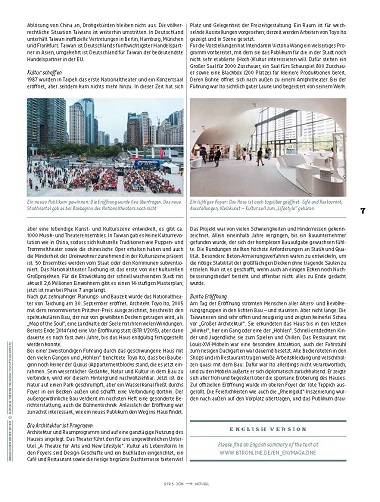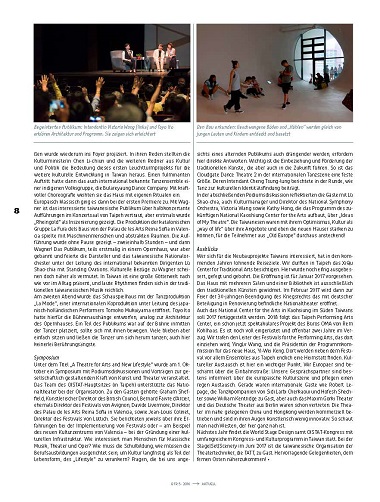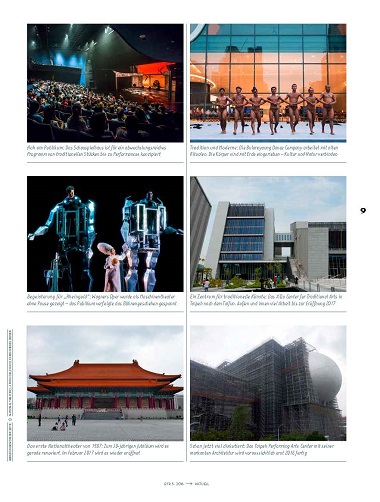An article on BTR-Bühnentechnische Rundschau
The magazine for stage technology, theatre architecture and scenography.
By KARIN WINKELSESSER
View the article in English
Download the English version of the article
Download the original article in German





The small island state in the West Pacific is investing in culture. The national theatre of Taichung, designed by Japanese architect Toyo Ito, is just the first project in a series of new and spectacular cultural buildings. Taiwan is engaging in cultural exchange to join in the global community. On 30 September, its striking national theatre opened to European guests with the Valencian production of “Rhinegold” and an extensive accompanying programme.
By KARIN WINKELSESSER
To coincide with the inauguration of the new national theatre of Taichung, the Taiwanese Ministry of Culture invited a small group of journalists to view other construction projects in the capital city Taipei and to talk to art-makers and the Ministry of Culture, as well as attend the opening night. We had an intensive schedule ahead of us – assisted by the all-round care of a dedicated young team of organizers. We arrived in Taipei at the tail-end of the terrible typhoon that uprooted trees, tossed construction site fences through the air and floored row after row of mopeds. Determined but amazingly composed, road workers were getting to grips with the clearing-up. The damage was worse in the south of the island, but the city Taichung in the interior was hardly hit at all. At talks in the Ministry of Culture, the Deputy Minister Dr. Pierre Tzu-pao Yang and his heads of department outlined his ministry’s activities to us journalists. He stressed his hopes that culture and especially cultural exchange would contribute to increasing national self-confidence and the “sense of freedom” that is a pillar of democracy. This is, after all, still young in Taiwan. Having fled China following the Communist victory, the Kuomintang government led by Chiang Kai-shek established Taipei as its seat in 1949. Chiang Kai-shek governed the island as an authoritarian one-party state for four decades. It was not until 1987 that the ruling KMT lifted martial law. President Tsai Ing-wen of the Progress Party DDP, incumbent since May, is now striving toward Taiwan’s increasing detachment from China. Taiwan’s status is still disputed, and a certain amount of sabre-rattling is inevitable. In Germany, Taiwan maintains unofficial representations in Berlin, Hamburg, Munich and Frankfurt. Taiwan is Germany’s fifth most important trade partner in Asia; conversely, Germany is Taiwan’s most important trade partner in the EU.
Making culture
The country’s first national theatre and a concert hall were opened in 1987 and remained the only major cultural venues until now. But in the meantime a lively art and culture scene has developed, with some 1000 music and drama ensembles. Because Taiwan experienced a cultural revolution like China, cultural traditions such as puppet and drum theatre and Chinese opera have survived, and the native Taiwanese minority is also increasingly involved in the arts scene. 50 ensembles are subsidized by the state or local authorities. The Taichung national theatre is the first of four major cultural projects planned by the government. A 14-step masterplan has been devised for the rapidly growing city, currently with a population of 2.6 million. So far, phase 7 has been reached.
The national theatre of Taichung was opened on 30 September, following ten years of planning and construction. The architect, Toyo Ito, winner of the prestigious Pritzker Prize in 2005, describes the spectacular building with its exclusively vaulted ceilings, winding passages and caves, as a “map of the soul”. A pre-opening took place in late 2014 (see BTR 1/2015) but it took almost another two years for the building to be finally completed.
During a two-hour tour of the building, Toyo Ito told us that when construction started none of the (luxury) apartment blocks that now frame it had been built. Imagining it without them, it is easier to understand his central idea of combining nature and culture. Now, the natural element has shrunk to a park, but a canal flows through the foyer into a pool outside, creating a connection between the two. The extraordinary building along with its stage technology deserves separate consideration – to be featured in the next issue. For now, it was interesting to see how the theatre attracted a new audience for the opening.
Architecture on the programme
The architecture and the space have been designed specifically for all-day use. Perhaps surprisingly to western ears, the venue is also named “A Theatre for Arts and New Lifestyle”. It embodies culture as a way of life: As well as designer stores and a bookshop in the foyers, there is a café and a restaurant and a huge roof-garden terrace offering plenty of space and opportunity to spend one’s leisure hours. One room has been set aside for temporary exhibitions; works by Toyo Ito are currently on show.
Artistic Director Victoria Wang has prepared a diverse programme of performances, which she hopes will awaken the public’s interest in (high) culture – a relatively new arrival in the city. A large hall seating 2000, a hall for drama with capacity for 800, and a blackbox (seating 200) for smaller productions are at her disposal. The stage can be opened up to become an amphitheatre. During our tour, Toyo Ito was in a visibly good mood and excited about his work. The project had been attended by many difficulties and setbacks. It took one-and-a-half years to find a contractor who was prepared to take on the complex building tasks. The venue’s many curves demanded complicated structural engineering calculations and the highest quality work. Special procedures for reinforcing concrete had to be developed to achieve the necessary stability for the expansive ceilings without supporting columns. Now everything is complete, save for a few small improvements where some aspects were not quite thought through to the end.
Colorful opening
On the day of the opening, people of all ages and classes swarmed to the brightly sunlit building - and were awestruck. But not for long. With their characteristic openness and curiosity, the Taiwanese public proved not in the least intimidated by the grand architecture. They set about exploring all the building’s twists, turns and nooks. Children and youngsters felt particularly at home in the “caves”, lingering there to play and chill. The restaurant fitted with Louis XVI furniture was a special attraction, as was the lift to the enormous roof-garden, which was permanently in use. The staff in the shops and restaurant wore white, blending in with their architectural surroundings. This, however, was not Toyo Ito’s decision, and when questioned about the furniture he responded with diplomatic reserve. But he was very glad about the public’s reception. For the official opening, the red carpet was rolled out in the upper foyer. The celebrations and the “Rhinegold” performance were broadcast in the forecourt outside, and live footage of the audience outside was projected into the foyer. Culture Minister Cheng Li-chiun and other figures from the worlds of culture and politics gave speeches underlining the importance of this lighthouse project for Taiwan’s cultural development. The internationally renowned indigenous dance ensemble Bulareyaung Dance Company then gave a brilliant performance, inaugurating the building with their own rituals embedded in a powerful choreography. Marking a contrast to this, the first premiere was classically European. The concert-going Taiwanese public was already familiar with Wagner from performances in the Taipei concert hall but this was the first time “Rhinegold” was staged in the country. The production by Catalonian group La Fura dels Baus of the Palau de les Arts Reina Sofia in Valencia featured human machines and abstract spaces, and showed the full two-and-a-half hours of Wagner without any interval. The audience, some of them newcomers to the opera, was mesmerized and rewarded the performers and the Taiwanese national orchestra under the direction of internationally renowned conductor Lü Shao-chia with standing ovations. There seem to be more Taiwanese points of identification with Wagner than one might think. The world of the gods is still an important element in Taiwanese life, and traditional Taiwanese music is characterized by loud rhythms.
On the second evening, the dance production “La Mode”, an international coproduction directed by the Japanese-Dutch performer Tomoko Mukaiyama, opened the drama theatre. Toyo Ito created the stage backdrops here to correspond with the architecture of the opera house. Some of the audience were placed on the stage among the dancers and intended to move along with them. However, many of them simply remained seated and let the performers dance around them. Here, too, they did not show any fear of getting close to the action.
Symposium
On 1st October a symposium was held under the banner of “A New Theatre for Arts and New Lifestyle” with podium discussions and lectures on the power of the arts to shape society, co-organised by the team from the OISTAT headquarters (in Taipei) and the national theatre. Guests included Graham Sheffield, artistic director of the British Council, Bernard Faivre d’Arcier, former director of the Avignon Festival, Davide Livermore, director of the Palau de les Arts Reina Sofia in Valencia, and Jean-Louis Colinet, director of the Liège Festival. They talked about their experiences staging festivals and building cultural infrastructure – one example being Valencia’s new arts centre. Hot topics were: How do you get people interested in classical music, theatre and opera? What kind of schooling and professional training is necessary to permanently anchor culture in the public’s lifestyle? These questions, which are also relevant to us because of our aging audiences, demand immediate answers here. The importance of including and promoting traditional arts but also carrying them into the future was stressed. The Cloud Gate Dance Theatre of Taiwan is a successful example of this and firmly established on the international dance scene. The director of Cloud Gate 2, Cheng Tsung-lung, told the attendees how dance contributes to forming cultural identity.
In the concluding podium discussion, Lü Shao-chia (also the music director of National Symphony Orchestra), Lee Huey-mei (the executive and artistic director of National Theater & Concert Hall), Victoria Wang and Kathy Hong (the director of marketing & communications, National Kaohsiung Center for the Arts (Weiwuying) ) talked with the guests about “ideas of my theatre”. The Taiwanese displayed such optimism about consolidating culture as a way of life through events and especially the new venues that it even caught on among the participants from “old Europe”.
Looking ahead
Anyone interested in Taiwan’s construction projects has plenty to visit in the coming years. We were taken to view the Xiqu Center of Taiwan, the venue for traditional arts, located in Taipei. Workers were still busily drilling, sweeping and putting the finishing touches to the building, due to open in January 2017. With several halls and a library, the venue is exclusively dedicated to the traditional arts. In February 2017, to mark 30 years since the end of martial law, the national theatre, which is currently being renovated with the participation of German firms, will also be opened.
The National Kaoshiung Center for the Arts (Weiwuying) in southern Taiwan is also due to be completed in 2017. In 2018 the Taipei Performing Arts Center, a spectacular project by Rem Kohlhaas’ OMA firm, is due to follow, though it is currently surrounded by scaffolding and apparently two years behind schedule. We met Yi-Wei Keng, the director of Taipei Arts Festival, and YingLv Wang, the manager of production and marketing department of Taipei Performing Arts Center. It is intended to be a home not only for the festival but also a number of ensembles from Taipei. Cultural exchange is an important point here, too. We Europeans are embarrassed about the one-way traffic: Everyone we talk to here is very well informed about the European arts scene and cultivates lively exchange. International guests such as Robert Lepage, the dance companies of Sidi Larbi Cherkaoui and Hofesh Schechter, and William Kentridge have all been recent guests, and Berlin’s own Maxim Gorki Theater and Deutsche Theater have also made appearances. The theatres in neighbouring China and Hong Kong are commercially run. In Taiwanese eyes, they lack artistic innovation. So they prefer to look to the West, which now seems very near.
Next year the World Stage Design and OISTAT congress will be held here with an extensive accompanying programme. The Taiwanese stage technicians’ organization, TATT, will be guests at the Stage|Set|Scenery in June 2017 – excellent opportunities to get closer to the Far East!
Photos:
Attracting a new public: The opening was broadcast live. The national theatre is in a new quarter that didn’t yet exist when construction began.
The airy foyer: The building is open all day. With a café, restaurant, exhibitions, and smaller-scale performing arts, it aims to make culture part of the local lifestyle.
A thrilled audience: Artistic director Victoria Wang (left) and Toyo Ito explain the architecture and the programme – and seem relieved at the enthusiastic reception.
Exploring the building: The rounded floors and “caves” are a big hit with youngsters and children.
Tailored to the audience: The drama theatre will show a varied programme from traditional pieces to postmodern performances.
Tradition and innovation: The Bulareyaung Dance Company works with ancient rituals. The dancers’ bodies are covered in earth, combining culture and nature.
An eagerly received “Rhinegold”: Wagner’s opera was shown as a theatre of machines with no interval – the audience was spellbound.
A major new venue for traditional arts: The Xiqu Center of Taiwan after the typhoon. There is still a lot of work to be done before the opening in 2017.
The first national theatre: Built in 1987, it is being renovated in time for its 30th anniversary, and due to reopen in February 2017.
Already a subject of controversy: The Taipei Performing Arts Center with its striking architecture will probably not be completed until 2018.